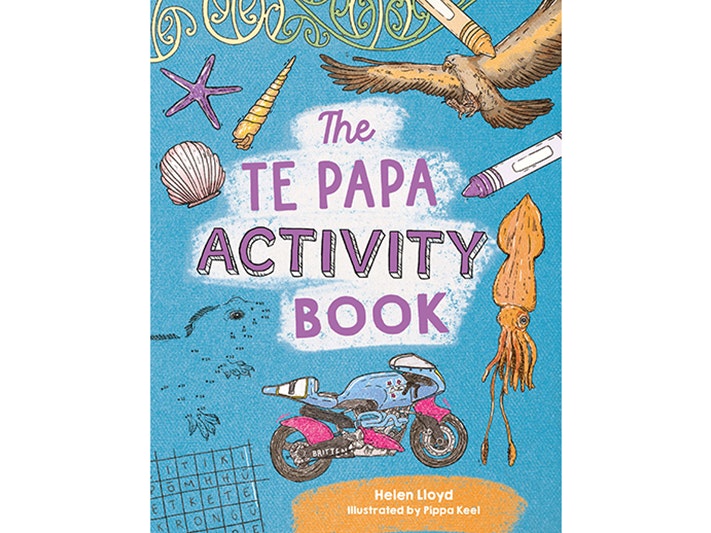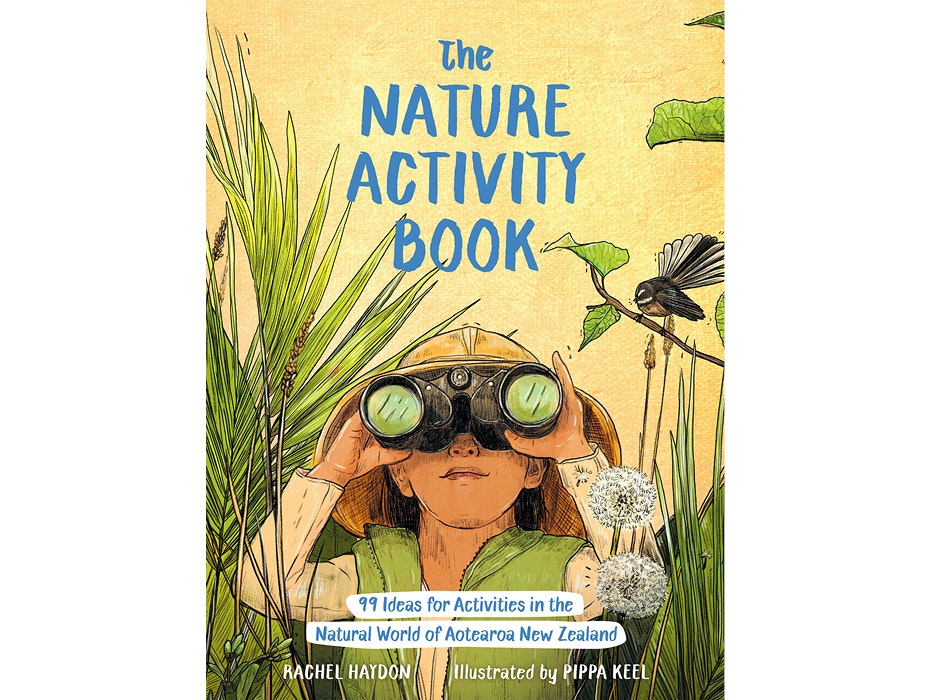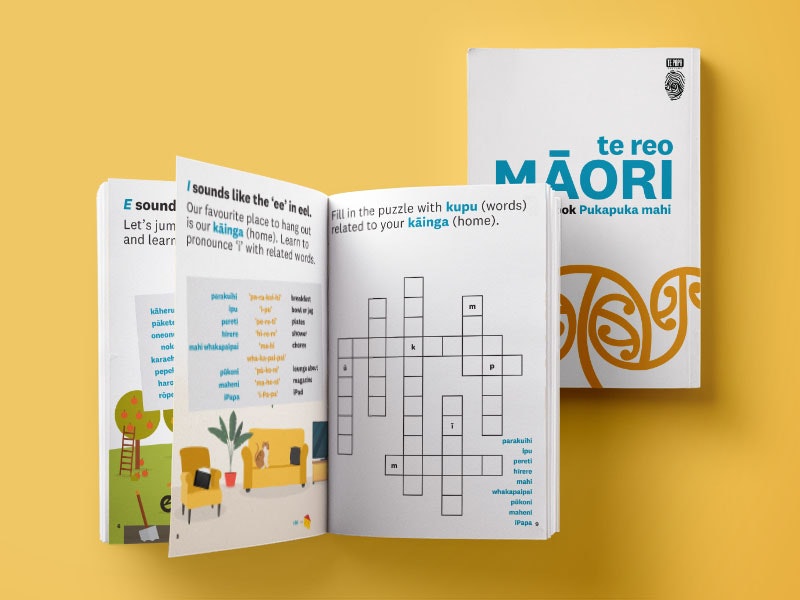
The Te Papa Activity Book
Fun activities about Te Papa Tongarewa and the taonga (treasures) we hold.
Free museum entry for New Zealanders and people living in New Zealand
Open every day 10am-6pm
(except Christmas Day)
Free museum entry for New Zealanders and people living in New Zealand
The author and illustrator of The Te Papa Activity Book discuss their work with Te Papa Press.
Helen Lloyd (left). Photo by Yoan Jolly, Te Papa, and Pippa Keel (right)..
Helen Lloyd is a qualified art teacher with a visual art and art history degree and a Master’s degree in museum and gallery education. She has 20 years’ experience of teaching art to children of all ages in schools, museums, and galleries in the United Kingdom, Russia, and New Zealand. Author of the popular New Zealand Art Activity Book and many online art resources, she is committed to developing inspiring creative learning experiences for children of all ages.
Pippa Keel is an award-winning illustration designer, with an honour’s degree in illustration and a huge love of the great outdoors! From her small studio in Te Whanganui-a-Tara Wellington, Pippa collaborates with a variety of clients. During the warmer months, she travels around Aotearoa to hand-paint murals.
Helen: I hope kids will find themselves engrossed in the activities in this book, be intrigued by the /taonga on its pages and be curious to learn more. I hope that through using this book, kids and whānau will discover new stories about Te Papa’s collections. Ultimately, I’d love this book to become a treasure in itself – a souvenir of a museum visit, full of memories, writing, drawings, and kids creativity.
Pippa: I really hope this allows kids to engage with some of the exciting taonga and exhibits in new ways, whether they are visiting the museum or enjoying the book at home! Even working on it allowed me to see parts of the museum in totally new ways, so I’d love for them to be able to share that experience.
Helen: I’d love to see kids using the book within the museum. Most of the activities are inspired by exhibits currently on display at Te Papa, so in that respect it doubles up as a museum guide for young visitors. By using the book as part of a visit kids can learn fun facts and gain new insights as they journey through the museum. Some activities encourage kids to look beyond what’s on the page, to find other related objects and stories on display, so it could also prompt families to visit parts of the museum they haven’t seen before.
Helen: For kids who have never been to Te Papa, it will give them a taste of what the museum is like. Some of the activities are inspired by things in Te Papa’s collection stores, so in addition to being a guide for visitors, it’s also a bit of a peek behind the scenes. I have designed the activities so that they can be done anywhere, with or without a visit.
Helen: Certain exhibits within the museum have developed an iconic status – these were obvious choices for inclusion because they are such firm favourites with our visitors, things like our marae, Rongomaraeroa, our nature exhibit Te Taiao | Nature, with the giant Haast's Eagle and the colossal squid, our Pacific exhibition Tangata o le Moana, and historical items such as Phar Lap and the Britten Bike. But Te Papa is kaitiaki or guardian for so much more than the exhibitions at the museum. With millions of other items in our collection stores, the activity book also shines a light on some of Te Papa’s rarely seen treasures. If I wasn’t limited by how many pages we had in the book, I could have gone on an on!
Helen: The intention behind the art activity book was to introduce kids to artists in Te Papa’s collection. The activities it features are designed for kids to learn how to use different techniques and approaches when making art. With The Te Papa Activity Book I wanted to create a book that would appeal to a wide range of kids and include most subject areas within the museum – Māori and Pacific cultures, art, history, and nature. It is designed to be very accessible and fun, with familiar activities such as join-the-dots, word searches, colour-by-numbers, match-up activities, and colouring-in pages. Anecdotally I know that many teachers use activities from the art activity book in their art classes, and hope the same will happen with this one!
Pippa: Something I loved about working on this book was how I could actually visit Te Papa and engage with the things that I was drawing – or look them up via Collections Online! It felt like I was really connecting with the taonga and experiencing them in deeper ways, which made it quite different to working on the nature-focused books. Those were still fun!
Pippa: The most fun illustrations to draw were probably all of the historical treasures! In particular the old-fashioned shoes – they are so different to what we wear now and it’s fun to look for differences with objects like that. And the most challenging illustration was definitely the dot-to-dot drawing of Phar Lap! Horses are tricky, let alone horse skeletons – phew!
Creating a book like this takes time and care, and it is reliant on the multiple relationships Te Papa holds with not only the people who created taonga in our collections but also those who whakapapa to them through genealogical links. I am immensely grateful for the input from many expert colleagues within Te Papa, including our te reo Māori writers, Māori curators, Māori advisors, Iwi Relationships Team, and our Kaihautū, who all contributed their invaluable knowledge and advice about the taonga and te reo Maori within the book. And most importantly I want to thank all the artists and their whānau, who gave us permission to feature their taonga, I am thrilled by their inclusion, and excited to be giving kids new ways to connect with them.
Helen: One of the things I love about working at Te Papa, is that there are so many new things to learn – insights about collection items are constantly being revealed by the experts around me! But during this book, I also learned more about the museum building and its surroundings. I discovered that there is a central shaft running through the architecture of the building that traces an earthquake fault line. And the three boulders on the forecourt at the entrance to the museum represent Papatūānuku or the Māori earth mother, Tangata whenua the indigenous people of Aotearoa, and Tangata Tiriti, the post-Treaty people of New Zealand. I walk past these boulders every day, and I now have a new level of appreciation and connection with them!
Pippa: Void, which is a drawing of an artwork by Bill Culbert and Ralph Hotere. Having previously worked at the museum, I’d walked over it countless times but I had never stopped to fully appreciate it. I learnt that the rubber in that bottom space is meant to disrupt the sound of people’s footsteps and create a quiet space. But more surprisingly, I also discovered that when they cut the marble there, they uncovered a circle that was reflected in the original plans – apparently a tree was originally supposed to be planted there. A giant living kauri, in the centre of Te Papa. So that was pretty cool to learn!
Helen: It’s impossible to choose just one activity. I loved designing and testing them all. Counting the eyes in the carved waharoa gateway was both mesmerising and tricky but very satisfying. Joining the dots was always a thrill and a lovely nostalgic throw back to my own childhood. Matching the body parts on the colossal squid was fun, and colouring in the sculpture of Māui and his brothers was a highlight, but I’m most excited to see what young readers and visitors create for the activities where they can draw their own treasures and curate their own collections!
Pippa: A very hard question to answer! I think maybe the Bush City map activity, because it is super interactive and gets you outside, which I like. And it was really fun to draw!

Fun activities about Te Papa Tongarewa and the taonga (treasures) we hold.

From experiments and observation to conservation and mindfulness, this activity-packed book stimulates curious minds. It encourages children to relate to the natural world and develop budding research skills.

Our activity books are designed for use at home or in the classroom. We’d love to hear your feedback or ideas for other subjects.